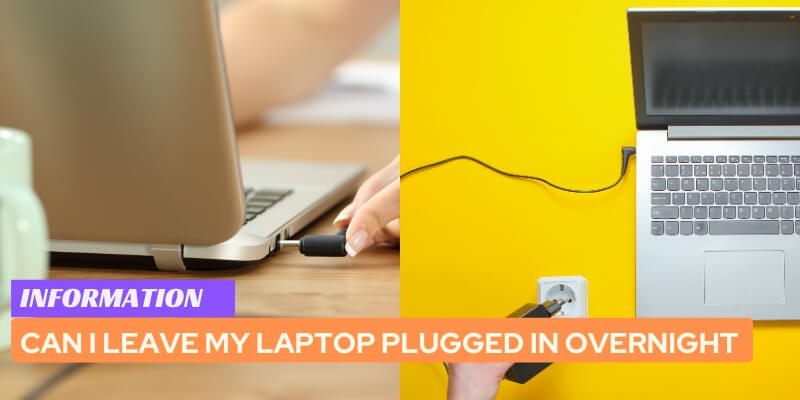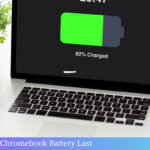Yes, it is safe to leave your laptop plugged in overnight without causing any damage. Leaving your laptop plugged in overnight will not overcharge the battery.
However, it is recommended to use a power strip with surge protection to prevent any power surges or fluctuations that may occur during the night.
When it comes to using your laptop, one common concern is whether it is safe to leave it plugged in overnight.
Many people worry that constantly having their laptop connected to a power source could harm the battery.
However, I am here to assure you that there is nothing to worry about. You can leave your laptop plugged in overnight without causing any damage.
Contrary to popular belief, modern laptops are designed with smart charging systems that prevent overcharging.
In fact, it is even recommended to keep your laptop plugged in whenever possible, as it helps to maintain a consistent power supply.
Table of Contents
- How Does Laptop Power Consumption Work?
- Debunking Common Myths About Laptop Power Consumption
- Optimal Charging Practices For Laptop Power Efficiency
- Carbon Footprint Of Laptop Power Usage
- Sustainability And Energy Efficiency Features
- Energy Costs Of Leaving The Laptop Plugged In Overnight
- Practical Tips For Reduction Of Power Consumption
How Does Laptop Power Consumption Work?
Laptop power consumption varies depending on usage and settings. It is generally safe to leave your laptop plugged in overnight, but minimizing power consumption and battery wear can help prolong battery life.
Have you ever wondered how much power your laptop consumes in different modes? Understanding how laptop power consumption works is essential in managing its energy usage and optimizing battery life.
In this section, we will explore the energy usage of laptops in different modes as well as delve into the functioning of laptop power supply and battery.
1. Energy Usage Of Laptops In Different Modes:
- Idle Mode: When your laptop is idle and not performing any tasks, it still consumes a certain amount of power. This power consumption is relatively low but not negligible.
- Sleep Mode: Putting your laptop to sleep saves more power compared to leaving it idle. In this mode, your laptop enters a low-power state, suspending most operations while still keeping your data intact. Although sleep mode consumes less power, some background tasks may still run.
- Hibernation Mode: Hibernation mode is similar to sleep mode, but it consumes even less power. When your laptop is in hibernation, it saves the current state to the hard drive and shuts down completely, significantly reducing power consumption. This mode is particularly useful when you won’t be using your laptop for an extended period.
- Active Mode: When you are actively using your laptop, whether it is browsing the internet, watching videos, or working on documents, it consumes the most power. Your laptop’s processor, display, and other components are all working at full capacity to deliver the performance you need.
Understanding these different modes of power consumption can help you make informed decisions about when to use sleep, hibernate, or shut down your laptop.
By using the appropriate mode based on your usage patterns, you can effectively manage power consumption and extend battery life.
2. Understanding Laptop Power Supply And Battery Functioning:
- AC Power: When you plug your laptop into a power outlet, it runs on alternating current (AC) power. The AC power adapter converts the electrical energy from the outlet to power your laptop and charge its battery simultaneously.
This allows you to use your laptop continuously without relying solely on battery power. - Battery Power: Laptops are equipped with rechargeable lithium-ion batteries that provide power when not connected to an outlet. These batteries store electrical energy and can be recharged multiple times.
Battery power is essential for portable usage, allowing you to work without being tethered to a power source. - Battery Charging: When your laptop is plugged in, the AC power adapter charges its battery. The charging process occurs automatically and is managed by the laptop’s internal circuitry.
Once the battery reaches its full charge, the charging process stops to avoid overcharging, which can negatively impact the battery’s lifespan.
Now that we have covered the basics of laptop power consumption and how it relates to different modes and power sources, you have a better understanding of how to manage your laptop’s power usage.
By making conscious choices and optimizing settings, you can maximize battery life and ensure efficient energy consumption.
Debunking Common Myths About Laptop Power Consumption
Discover the truth behind laptop power consumption myths. Find out whether you can safely leave your laptop plugged in overnight without worrying about damaging the battery.
Is it safe to leave your laptop plugged in overnight? Can switching your laptop off every night help conserve energy? These are common questions that many laptop owners have.
In this section, we’ll debunk some of the common myths surrounding laptop power consumption and provide expert opinions to set the record straight.
1. Leaving The Laptop Plugged In Constantly Damages The Battery
- Leaving your laptop plugged in does not damage the battery: Contrary to popular belief, leaving your laptop plugged in constantly does not harm the battery.
Modern laptops are equipped with smart charging technology that prevents overcharging and helps maintain battery health. Once the battery is fully charged, the laptop will run on AC power directly, bypassing the battery. - Regularly draining the battery is unnecessary: It used to be common advice to completely drain the battery before recharging it to optimize its lifespan. However, this is not necessary with modern lithium-ion batteries found in laptops.
In fact, frequent deep discharges can actually harm the battery. It is better to keep the battery level between 20% and 80% for optimal performance and longevity. - Power management settings can help: By adjusting power management settings, you can optimize your laptop’s power usage.
For example, setting the display brightness to a lower level and enabling the sleep mode when the laptop is not in use can help conserve power and extend battery life.
2. Turning Off The Laptop Every Night Conserves Energy
- Standby mode is energy-efficient: Putting your laptop to sleep or into standby mode when not in use is more energy-efficient than completely shutting it down.
In standby mode, the laptop uses minimal power and can quickly resume when you want to use it again. This is especially useful for users who frequently need to access their laptops throughout the day. - Shutting down is necessary for maintenance: While keeping your laptop in sleep mode is convenient, it is recommended to shut it down occasionally to perform system updates and allow for any necessary software maintenance.
This helps ensure that your laptop runs smoothly and efficiently. - Energy-saving features make a difference: Many laptops come with built-in energy-saving features, such as power-off USB ports and the ability to dim the screen after a period of inactivity. These features help conserve energy and reduce overall power consumption.
Leaving your laptop plugged in overnight and turning it off every night both have their benefits and drawbacks.
However, modern laptops are designed to handle being constantly plugged in, and it is more energy-efficient to put your laptop in standby mode when not in use.
By understanding the facts and utilizing power management settings, you can make informed decisions about power consumption and battery health for your laptop.
Optimal Charging Practices For Laptop Power Efficiency
Optimize your laptop’s power efficiency by following these optimal charging practices. Learn whether it is safe to leave your laptop plugged in overnight for convenient charging.
1. Can I Leave My Laptop Plugged In Overnight –
Laptops have become an integral part of our daily lives, serving as essential tools for work, entertainment, and communication.
But have you ever wondered about the best practices for keeping your laptop charged efficiently?
In this blog post, we will explore the optimal charging practices that can help maximize your laptop’s battery life and overall power efficiency.
Let’s dive in!
2. Charging Cycles And Battery Health:
- Limit the number of complete charging cycles:
- Each laptop battery has a limited number of complete charging cycles it can undergo before its capacity starts to decline.
- Completing a charging cycle means using all the battery power from 100% to 0% and then fully charging it to 100% again.
- If possible, avoid letting your laptop’s battery level drop too low before recharging it.
- Avoid extreme temperatures:
- High temperatures can negatively impact your laptop’s battery health, reducing its overall capacity.
- Similarly, low temperatures can make it more challenging for the battery to discharge power effectively.
- Keep your laptop in a cool and dry environment, away from direct sunlight and extreme temperatures.
3. Recommendations For Smart Charging And Maximizing Battery Life:
- Utilize the battery saver mode:
- Most laptops offer a battery saver mode that helps conserve power by adjusting settings such as screen brightness, background app activity, and system performance.
- Activating this mode can significantly extend your battery life during periods of extended use when a power outlet may not be readily available.
- Unplug your laptop when fully charged:
- Once your laptop reaches a full charge, it is advisable to unplug it from the power source.
- Extended periods of being plugged in at full charge can potentially strain the battery by constantly topping it up unnecessarily.
- Avoid deep discharges:
- Allowing your laptop’s battery to fully discharge frequently can contribute to its wear and tear over time.
- Instead, aim to recharge it when the battery level reaches around 20% to 30% for optimal longevity.
- Keep laptop software up to date:
- Regularly updating your laptop’s software, including the operating system and drivers, can help optimize power management features.
- These updates often include improvements and bug fixes focused on enhancing power efficiency.
- Remove external peripherals when not in use:
- External devices such as USB drives, printers, or external hard drives draw power from your laptop.
- If they are not in use, disconnect them to minimize unnecessary power drain and maximize battery life.
- Adjust power settings:
- Tailor your laptop’s power settings according to your needs.
- Reducing the brightness of the display, shortening the idle time before sleep mode, and adjusting the performance settings can all contribute to power efficiency.
- Hibernate or sleep mode:
- Utilize your laptop’s hibernate or sleep mode when you’re not actively using it for an extended period.
- These modes save power by temporarily suspending operations and turning off non-essential components.
By implementing these optimal charging practices, you can extend your laptop’s battery life and improve power efficiency.
Remember to be mindful of charging cycles, avoid extreme temperatures, and take advantage of power-saving features.
With these steps, you can enjoy a longer-lasting and more efficient battery for your laptop. So go ahead, make the most of your device while keeping it powered up smartly!
Carbon Footprint Of Laptop Power Usage
Leaving your laptop plugged in overnight can contribute to its carbon footprint, as it continues to draw power even when fully charged. It’s best to unplug it when not in use to minimize energy consumption.
Laptops have become an essential part of our lives, used for work, entertainment, and everything in between.
But have you ever wondered about the environmental impact of leaving your laptop plugged in overnight?
In this section, we’ll explore the carbon footprint of laptop power usage to help you make more eco-friendly choices.
1. Calculating Energy Consumption And Emissions:
- Laptops consume varying amounts of energy, depending on factors such as the model, screen size, and usage intensity.
- To calculate the energy consumption, you need to multiply the laptop’s wattage by the number of hours it is plugged in.
- On average, a laptop consumes approximately 50 watts per hour while in use, and around 2-5 watts per hour when in sleep mode or idle.
- It’s important to note that laptops still draw a small amount of power even when fully charged and plugged in.
2. Comparing Laptop Energy Usage To Other Devices:
Laptops are often considered more energy-efficient than desktop computers. However, it’s still important to be mindful of their power usage.
Here’s a comparison of laptop energy usage to other common devices:
- Desktop computers: On average, a desktop computer consumes around 200-300 watts per hour, significantly higher than laptops.
- Televisions: Depending on the size and model, TVs can consume anywhere from 30 to 400 watts per hour.
- Light bulbs: Traditional incandescent bulbs use around 60 watts per hour, while energy-efficient LED bulbs use only 6-10 watts per hour.
- Smartphones: In comparison to laptops, smartphones consume negligible power, typically less than 2 watts per hour.
Remember, the energy consumption of laptops can vary depending on various factors, such as hardware components and settings.
However, by understanding the carbon footprint of laptop power usage and comparing it to other devices, you can make informed decisions to reduce your environmental impact.
By optimizing your laptop’s power settings, ensuring proper ventilation, and practicing responsible charging habits, you can contribute to a greener future.
So, the next time you wonder if leaving your laptop plugged in overnight affects the carbon footprint, consider these factors and make a conscious choice that aligns with your eco-friendly goals.
Sustainability And Energy Efficiency Features
Laptop sustainability and energy efficiency features allow you to leave your laptop plugged in overnight without harm.
These features ensure optimal performance and reduce energy consumption for a greener and more sustainable computing experience.
With the increasing focus on sustainability and energy conservation, it’s essential to consider the impact of our electronic devices, such as laptops, on the environment.
Leaving your laptop plugged in overnight is a common practice, but does it align with sustainable practices?
Let’s explore the sustainability and energy efficiency features that can address this concern.
1. Energy Star Ratings:
Energy Star ratings are certifications awarded to electronic devices that meet specific energy efficiency criteria.
Here’s why it matters:
- Energy-saving benefits: Laptops with Energy Star ratings consume less energy than non-certified ones, resulting in reduced electricity usage and lower utility bills.
- Environmentally responsible: By opting for laptops with Energy Star ratings, you contribute to reducing greenhouse gas emissions and help combat climate change.
- Long-term cost savings: Energy-efficient laptops not only reduce your carbon footprint but also save you money in the long run.
2. Eco-Mode Options:
Many laptops offer eco-mode options that can enhance energy efficiency.
Take a look at the benefits:
- Power management settings: Eco-mode features typically include customizable power settings that optimize energy usage, such as dimming the display brightness, adjusting processor speed, or initiating sleep mode during periods of inactivity.
- Prolonging battery life: By activating eco-mode settings, you can extend your laptop’s battery life, reducing the need for frequent charging and preserving battery health.
- Convenient and eco-friendly: Eco-mode options are designed to balance energy conservation with user comfort, ensuring you can use your laptop efficiently while minimizing its impact on the environment.
Considering energy-efficient features like Energy Star ratings and eco-mode options can make a difference in reducing the ecological footprint of your laptop usage.
By choosing laptops with such sustainability features, you contribute to a greener future while enjoying the convenience of your device.
Remember, sustainability isn’t just a buzzword; it’s a responsibility we all share. Embracing energy-efficient practices and supporting manufacturers committed to sustainable production is a vital step towards a more environmentally conscious world.
So, let’s make sustainable choices when it comes to our laptops and other electronics.
Energy Costs Of Leaving The Laptop Plugged In Overnight
Leaving your laptop plugged in overnight can contribute to higher energy costs. It is advisable to unplug it when not in use to save on electricity consumption.
Leaving your laptop plugged in overnight may seem convenient, but have you ever wondered about the energy costs associated with this habit?
Understanding the impact on your monthly bills can help you make an informed decision. Let’s delve into the energy costs of leaving your laptop plugged in overnight, considering electricity rates and usage calculation.
1. Understanding Electricity Rates And Usage Calculation:
- Electricity rates: The cost you pay per kilowatt-hour (kWh) of electricity varies depending on your location and utility provider. Check your electricity bill or contact your provider to determine the exact rate applicable to you.
- Laptop power consumption: Laptops typically consume around 50 watts of power when in use. However, when in sleep or idle mode, their power consumption decreases significantly.
It’s essential to consider both active and standby power consumption when estimating the impact on energy costs. - Usage calculation: To calculate the energy consumption of your laptop, you need to consider the number of hours it is plugged in and in what mode (active or standby).
Multiply the power consumption (in watts) by the number of hours to determine the energy used in kilowatt-hours (kWh).
2. Estimating The Impact On Monthly Bills:
- Active mode: If your laptop consumes 50 watts of power and is in use for 8 hours every day, the energy consumption would be 0.4 kWh per day (50 watts x 8 hours).
Multiply that by the number of days in a month to estimate the monthly energy consumed in active mode. - Standby mode (sleep or idle): When in standby mode, your laptop consumes less power. Assuming a power consumption of 5 watts while in standby and considering an average of 16 hours of standby time per day, the energy consumed would be 0.08 kWh per day (5 watts x 16 hours).
Again, multiply by the number of days in a month to estimate the monthly energy consumed in standby mode. - Once you have the energy consumption in active and standby modes, multiply each value by your electricity rate (per kWh) to estimate the corresponding costs. By adding these costs together, you can determine the total impact on your monthly energy bills.
Remember, these are estimated values and may vary based on your laptop model, usage patterns, and electricity rates.
Consider these calculations as a starting point to get an idea of the potential costs associated with leaving your laptop plugged in overnight.
Understanding the energy costs of leaving your laptop plugged in overnight allows you to make an informed decision based on your individual circumstances.
By assessing your typical usage and considering the associated rates, you can manage your energy consumption more effectively and potentially reduce your monthly bills.
So, take a moment to evaluate your laptop usage and decide whether it’s worth keeping it plugged in overnight or adopting energy-saving practices.
Practical Tips For Reduction Of Power Consumption
Leaving your laptop plugged in overnight might seem convenient, but it can have an impact on power consumption. Follow these practical tips to minimize power usage and maximize efficiency.
Do you often wonder if it’s safe to leave your laptop plugged in overnight? Well, you’re not alone. Many people have concerns about the long-term effects of keeping their laptops connected to power for extended periods.
We’ll address this question and provide you with practical tips on how to optimize power consumption for your laptop.
1. Power-Saving Settings And Software:
- Adjust display brightness: Lowering the screen brightness level reduces power consumption significantly.
- Enable sleep mode: Setting your laptop to automatically go into sleep mode after a certain period of inactivity helps conserve power.
- Activate power-saving mode: This feature limits the system’s performance to save energy and prolong battery life.
- Optimize power plan settings: Customize power plans on your laptop to maximize power efficiency.
- Turn off unnecessary background applications: Closing unused programs and processes can minimize power usage.
- Unplug peripherals: Disconnect any external devices that are not in use to reduce power consumption.
- Update your operating system and drivers: Keeping your software up to date ensures compatibility and optimized power management.
- Utilize power-saving software: Consider using power-saving applications that monitor and optimize power usage, further reducing energy consumption.
- Disable unnecessary notifications: Reduce the frequency of notifications to minimize power drain.
2. Ways To Optimize Laptop Usage For Power Efficiency:
- Efficient multitasking: Close unused applications and avoid running several resource-intensive programs simultaneously.
- Utilize hibernation mode: When you need to leave your laptop idle for an extended period, hibernation mode saves more power than sleep mode.
- Manage startup applications: Disable unnecessary programs from automatically launching at startup to conserve power.
- Adjust power settings for Wi-Fi and Bluetooth: Enable power-saving options for wireless connections to minimize power usage.
- Clean and maintain your laptop: Regularly clean dust and debris from vents and ensure proper airflow to prevent overheating, which can drain more power.
- Avoid extreme temperatures: High temperatures increase power consumption, so ensure your laptop operates in a cool environment.
- Use a power-efficient browser: Certain web browsers are designed to minimize power consumption, making them ideal for battery life optimization.
By implementing these practical tips, you can reduce power consumption and optimize the energy efficiency of your laptop.
Not only will you save energy, but you’ll also prolong your laptop’s battery life, enhancing its overall performance. Happy computing!
Frequently Asked Questions for Can I Leave My Laptop Plugged In Overnight
Is It Ok To Keep Laptop Plugged In Overnight?
Does Leaving A Laptop Plugged In Ruin The Battery?
Can A Laptop Be Left On 24 7?
Can Leaving My Laptop Plugged In Overnight Damage The Battery?
Is It Safe To Leave My Laptop Charging Overnight?
Will Leaving My Laptop Plugged In Overnight Consume More Electricity?
Can I Keep My Laptop Plugged In Even When It Is Fully Charged?
How Long Can I Leave My Laptop Plugged In Before It Starts Affecting The Battery Life?
Should I Drain My Laptop Battery Before Plugging It In Again?
Can I Optimize My Laptop Battery Life By Only Charging It Partially?
Conclusion on Can I Leave My Laptop Plugged In Overnight
Leaving your laptop plugged in overnight is generally safe and won’t cause significant harm to your device.
However, to maintain the longevity of your laptop’s battery, it is best to unplug it once it reaches full charge.
Modern laptop batteries are designed to prevent overcharging, so there is no need to constantly monitor the charging process.
Nevertheless, it is important to keep in mind that excessive heat can still have a negative impact on the battery’s lifespan.
Therefore, ensure that your laptop is placed on a flat, well-ventilated surface to prevent overheating.
By following these simple guidelines, you can optimize the performance and durability of your laptop, allowing it to serve you for years to come.
Remember, taking care of your laptop is essential in maximizing its longevity and ensuring a smooth user experience.






